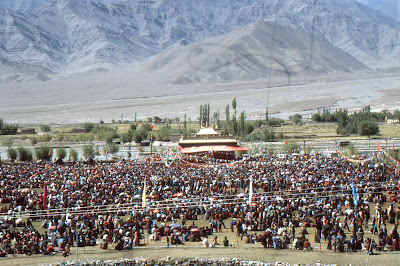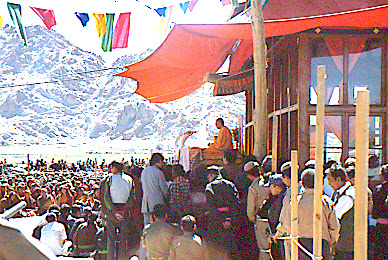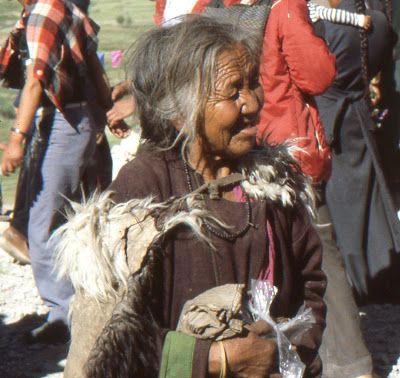 |
| The Crowd Assembling |
His Holiness the Dalai Lama was due to arrive in Leh, the capital of Ladakh, in early August to dedicate a shrine on a hilltop above town. I was told the shrine was about 13,200 feet up. I planned my trip so I'd be in town when HH was. I wanted to see what it would be like for him to be among his people, kind of like it would be if he could return to Tibet.
While I was on a different part of my trip, the date for the shrine dedication was postponed by two weeks. Because I was in China at that point, my savvy wife Mary knew that she'd have to be careful in notifying me about such a delicate subject. I received a telegram that said, NEW PERFORMANCE DATE FOR HELLO DOLLY STOP THE OPPOSITE OF YOUR MASTERCARD HAS BEEN CHANGED. Then there were dates and new flight details.
 |
| The Dalai Lama Speaking |
 |
| HH Heads Up to the Shrine |
 |
| At the Shrine, Note the Monastery Top Center |
What I want to focus on before I move to the second monk story, is what happened during the Dalai Lama's speech. I understood none of it, so I spent my time looking out the way he was, over the crowd of people squatting in the dust. During the preliminary talks by other monks, the crowd was pretty much like any other congregation held captive during a ceremony - people looked around, chatted quietly, a few ate snacks.
The moment the Dalai Lama started to speak, there was an intense change in the audience. The entire crowd seemed to sit back slightly, their shoulders went down. Little smiles appeared. Arms went down loosely to the ground. It looked an awful lot like a couple of thousand people meditating. They were listening of course, but it was more than that - they were receiving. Without wanting to over interpret, it was hard not to conclude that these people were doing what the Dalai Lama always talks about people doing, if you've read his writings: they were opening their hearts to him. En masse.
I have a strong memory of that afternoon, maybe partly because I couldn't understand the content - all I could do was soak up the mood, the shared spirit of so many otherwise quite alien folks. I left feeling the kind of warmth and sense of peace that comes after meditating or yoga or even a long hot bath.
Ten or twelve years later, back in Northern California, Mary and I heard about a talk being given by the Vietnamese Buddhist monk, Thich Nhat Hanh, at a huge church in San Francisco. We had read many of his books, and thought it would be worth the trip south to hear him in person. The Venerable Nhat Hanh is not comparable to HH the Dalai Lama in his branch of Buddhism - it's a different structure. But he is a revered leader and healer of hurt souls, and one who like HH has made a huge impression in the West.
The crowd in the tall stone gothic church was a bit smaller than the one in Leh, but still it must have been 1,000 people. Nhat Hanh spoke from the chancel, after a similar set of unmemorable speeches by other monks and notables. This time everything was in English.
The crowd was restless and noisy, but I knew they would settle down once the main speech began, especially because Thich (Venerable) Nhat Hanh has a small voice.
Boy, was I wrong. While his gentle, sweet words flowed, the revered monk was ignored. People chatted, ate, and there was a continuous thick rope of them wandering around all the aisles. Half the crowd was composed of people craning their necks looking around to see and be seen, like a congregation of prairies dogs - on amphetamines. I was alternately incandescent and humiliated. It was extremely difficult to stay focused - even to hear.
When I first met Mary in 1978, she was reading deeply in Ouspenky's writing on the Russian mystic George Gurdjieff. As was often the case with Mary's reconnoitering of the world's spiritual traditions, I couldn't understand most of it, and pretended to read the proffered impenetrable Russian philosophy because I was in love and wanted to impress her. The point Mary made over and over about that philosophy - until she died here on the salt marsh 32 years later - was to pay attention. Again and again, she said: just pay attention - the rest will work itself out. You don't, she said, really need to know anything else.
The crowd in San Francisco was more than superficial and self-absorbed, although lord knows, they were that. They seemed to be sitting outside of the event, evaluating it. They were too restless to pay attention, and too sealed in their concerns about style and appearance to discern what was offered. I think I was with a throng of people who saw themselves as givers (of judgement), but not as receivers.
Over 30 years, Mary taught me that paying attention involves humility, and a laying aside of fear. To become a piece of smooth wet clay, ready for an impression, you need to feel safe, without making appraisal or analysis. Those hardscrabble Ladakhi people squatting in the dust wearing yak skins, many with the pungency of folks who bathe twice a year - they were paying real attention, letting it in. This kind of attention is not passivity - it's confidence. It's trust. And it's gladly given and received power.
I love my fellow beings here in America - even those darn Republicans. But I fear for us, for our health and welfare and survival, if we unable to learn to pay attention, let go of our ego-driven analysis and our guilt-driven fear - and let the promise and wisdom and beauty all around us flow in.




